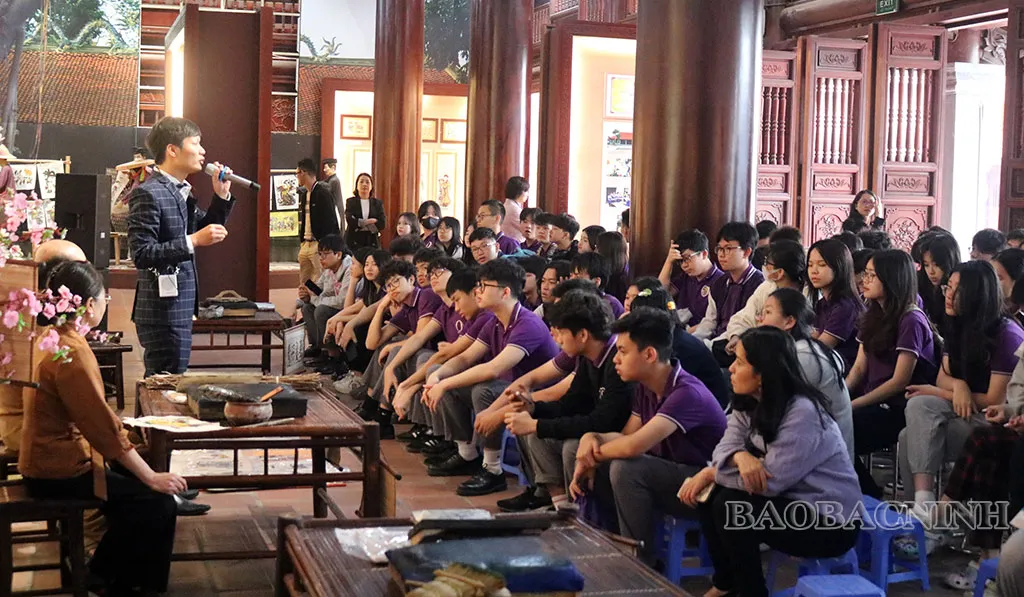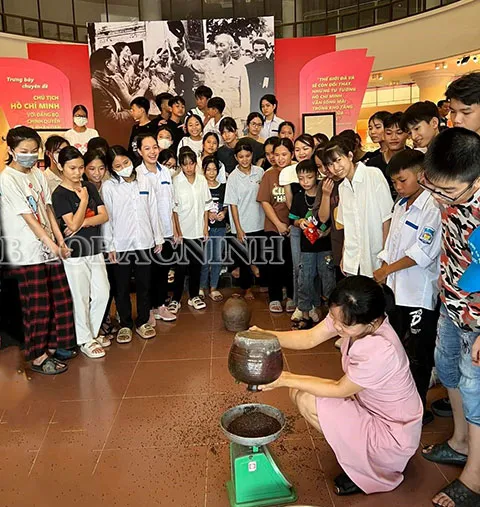Today, school tourism is no longer a foreign concept but has become an important part of the educational program in many schools in Vietnam. From visiting historical sites and scenic spots to cultural experiences and scientific explorations, school tourism offers invaluable lessons that are not limited to textbooks. This unique educational model is increasingly being emphasized and developed, opening up new horizons for the learning and growth of Vietnamese students.
Diverse Forms of School Tourism in Vietnam
School tourism in Vietnam is developing with diverse forms, meeting the needs and educational goals of each school and grade level. There are two main forms, each bringing unique values to students’ learning and development.
1. Sightseeing and Exploration: This is a popular form, focusing on taking students to famous tourist destinations, historical sites, scenic spots, museums, or cultural centers. The main goal of this form is to help students broaden their knowledge and enhance their understanding of history, culture, geography, and society. Trips are often designed for students to freely explore, observe, and learn through direct experiences.
2. Experiential Learning and Study: This form emphasizes combining tourism with experiential learning activities. Before each trip, teachers will provide basic information about the destination and assign specific learning tasks. During the visit, students will actively explore, collect information, carry out interactive activities, and discover. After the trip, they will summarize their knowledge and share their experiences through reports, learning projects, or other creative reporting forms. This form not only helps students master knowledge but also develops self-learning skills, teamwork, critical thinking, and problem-solving skills.

Besides, some schools also develop school tourism models combined with life skills training, social activities, or international cultural exchange programs. This diversity not only enriches the learning experience but also meets the comprehensive development needs of students in the 21st century.
Outstanding Benefits of School Tourism Experiences
School tourism brings countless practical benefits to students, making an important contribution to their education and comprehensive development. These trips are not just opportunities for fun and entertainment but also valuable lessons that deepen knowledge and nurture the soul.
1. Lively and Effective Learning: Instead of just learning through textbooks, school tourism helps students access knowledge in a direct, vivid, and relatable way. Witnessing historical sites firsthand, exploring museum artifacts, or experiencing local culture helps them easily visualize, remember, and understand the knowledge they have learned more deeply. History, geography, and culture lessons become more vivid and engaging than ever, sparking a passion for learning and discovery in students.
2. Skill and Competency Development: School tourism not only focuses on knowledge but also emphasizes the development of soft skills and necessary competencies for students. Participating in group activities, they learn how to work together, share responsibilities, resolve conflicts, and respect others’ opinions. Challenges during the trip help them develop self-confidence, flexible response skills, communication skills, and creative thinking.
3. Nurturing Love for Homeland and Country: Trips to explore the beauty of Vietnamese nature, culture, and history help students love and be proud of their homeland and country more. They are exposed to traditional values and unique cultural features of each region, thereby forming an awareness of preserving and promoting national cultural heritage. School tourism contributes to fostering national pride and patriotism in the younger generation.
4. Broadening Worldview and Enhancing Exchange: School tourism is not limited to the local area but also extends to other regions in the country and even internationally. These trips help students get in touch with new cultures and different customs, thereby broadening their worldview, enhancing their multicultural communication skills, and forming global thinking.

Suggested Attractive School Tourism Destinations
Vietnam has countless attractive destinations suitable for diverse school tourism programs. Here are some typical suggestions, categorized by different themes:
1. Exploring History and Culture:
- Bac Ninh: A land rich in historical and cultural traditions with famous relics such as Do Temple, Dau Pagoda, Dong Ho Painting Village, Phu Lang Pottery Village, Bac Ninh Temple of Literature. Bac Ninh is an ideal destination to learn about Dai Viet civilization and traditional cultural values.
- Hue: The ancient capital of Hue with the Imperial Citadel, tombs of Nguyen emperors, Thien Mu Pagoda, Perfume River, and Ngu Mountain imbued with historical and royal architectural imprints. Hue is a place where students can explore Vietnamese feudal history and the beauty of traditional culture.
- Hanoi: The thousand-year-old capital with the Temple of Literature – Quoc Tu Giam, Thang Long Imperial Citadel, National Museum of History, Bat Trang Pottery Village, Hanoi Old Quarter. Hanoi is a must-visit destination to learn about Vietnamese history, culture, and traditions.
- Hoi An: Hoi An Ancient Town with unique architecture, Japanese Covered Bridge, Tan Ky Old House, traditional craft villages. Hoi An is a place where students can explore the East-West cultural exchange and the beauty of ancient architecture.
2. Exploring Nature and Science:
- National Parks: National parks such as Cuc Phuong, Ba Vi, Tram Chim, Phong Nha – Ke Bang, Cat Tien… are great destinations for students to explore diverse ecosystems, learn about flora and fauna, and cultivate environmental protection awareness.
- Ecotourism areas: Ecotourism areas such as Trang An – Ninh Binh, Tam Coc – Bich Dong, Mekong Delta, Ha Long Bay… offer experiences close to nature, exploring the beauty of rivers, mountains, and traditional agricultural activities.
- Science museums: Science museums such as the Vietnam National Museum of Nature, Vietnam National Space Center, science and technology centers… are places where students can learn about science, technology, space, and discover the wonders of the natural world.
3. Experiencing Culture and Craft Villages:
- Traditional craft villages: Bat Trang Pottery Village, Van Phuc Silk Village, Dong Ho Painting Village, Chuong Conical Hat Village, Phu Vinh Bamboo and Rattan Weaving Village… are ideal destinations for students to learn about traditional handicrafts, meet artisans, and experience unique production processes.
- Traditional festivals: Participating in traditional festivals such as Giong Festival, Hung Kings Temple Festival, Nghinh Ong Festival, Gong Festival… helps students deeply understand the culture, beliefs, and customs of each region.
- Community-based tourism areas: Community-based tourism areas in Sapa, Mai Chau, Moc Chau, Pu Luong… offer opportunities to experience the cultural life of ethnic minorities, learn about customs, cuisine, and unique cultural activities.
Orientations for Developing Quality School Tourism
For school tourism to be truly effective and become an indispensable part of Vietnamese education, it requires the joint efforts of many stakeholders, from schools, families, tourism units to state management agencies.
1. Improving the Quality of Tourism Programs: School tourism programs need to be designed scientifically, systematically, and suitable for the age and educational goals of each grade level. Program content needs to be diverse, rich, harmoniously combining sightseeing, learning, and experience, ensuring educational value, safety, and attractiveness.
2. Strengthening Coordination Between Schools and Tourism Units: Schools and tourism units need to have close coordination in developing programs, organizing, and managing school tourism activities. Tourism units need to clearly understand the educational goals of the school, design suitable tours, and ensure service quality. Schools need to actively participate in the tour design process, prepare carefully for learning content, and manage students throughout the trip.
3. Diversifying Forms and Tourism Products: It is necessary to diversify the forms of school tourism, not only limited to traditional sightseeing tours but also developing types of experiential tourism, discovery tourism, ecotourism, cultural tourism, scientific tourism… At the same time, it is necessary to build distinctive, creative school tourism products that meet the needs and interests of students.
4. Investing in Facilities and Human Resources: It is necessary to invest in facilities and tourism infrastructure serving school tourism, especially at potential destinations. At the same time, it is necessary to train and foster tour guides, teachers, and tourism management staff with expertise, professionalism, and dedication to education.
5. Creating Favorable Conditions and Support Policies: State management agencies need to create favorable conditions in terms of legal regulations, administrative procedures, and support policies for school tourism development. There should be policies to encourage schools, tourism units, and social organizations to participate in developing school tourism.
Vietnamese school tourism is facing new opportunities and challenges. With proper attention, investment, and orientation, this unique educational model will increasingly develop strongly, making an important contribution to improving the quality of education, comprehensively developing Vietnamese people, and promoting the image of the country and culture to the world.